
A bumblebee is any of over 250 species in the genus Bombus, part of Apidae, one of the bee families. This genus is the only extant group in the tribe Bombini, though a few extinct related genera are known from fossils. They are found primarily in higher altitudes or latitudes in the Northern Hemisphere, although they are also found in South America, where a few lowland tropical species have been identified. European bumblebees have also been introduced to New Zealand and Tasmania. Female bumblebees can sting repeatedly, but generally ignore humans and other animals.

Bombus fraternus is an endangered species of bumblebee known commonly as the Southern Plains bumblebee. It is native to the United States east of the Rocky Mountains. It is most often encountered in the Southeast, in areas with sandy soil. They range from New Jersey to Florida, North Dakota, South Dakota, Nebraska, Colorado, and New Mexico. There has been a bee found in Chihuahua, Mexico It is uncommon today, having faced declines in population; its estimated abundance is less than 15% of historical numbers.
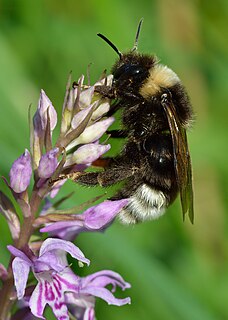
Cuckoo bumblebees are members of the subgenus Psithyrus in the bumblebee genus Bombus. Until recently, the 29 species of Psithyrus were considered to constitute a separate genus. They are a specialized lineage which has lost the ability to collect pollen and to rear their brood. They have lost the worker caste and produce only sexuals, male and female. They are inquilines in the colonies of other bumblebees. Before finding and invading a host colony, a Psithyrus female feeds directly from flowers. Once she has infiltrated a host colony, the Psithyrus female usurps the nest: she kills or subdues the queen of that colony and forcibly "enslaves" the workers of that colony to feed her and her developing young. When the young emerge, they leave the colony to mate, and the females seek out other nests to attack.

The tree bumblebee or new garden bumblebee is a species of bumblebee common in the European continent and parts of Asia. Since the start of the twenty-first century, it has spread to the United Kingdom and Iceland. These bumblebees prefer habitats that others do not, allowing them to pollinate flowers in areas that many other species do not get to.
Bombus polaris is a common Arctic bumblebee species. B. polaris is one of two bumblebees that live above the Arctic Circle. The other is its social parasite Bombus hyperboreus. B. polaris is a social bee that can survive at near freezing temperatures. It has developed multiple adaptations to live in such cold temperatures. B. polaris has a thicker coat of hair than most bees, utilizes thermoregulation, and makes insulated nests.
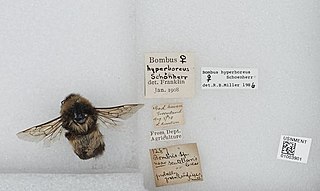
Bombus hyperboreus is a species of Arctic bumblebee with a circumpolar distribution. The species is primarily found in the arctic areas of Greenland, northern Scandinavia, and Russia. In 2015 the nearctic species, Bombus natvigi, was separated from this species, based on genetic analysis. Accordingly, Bombus hyperboreus is limited to the Palaearctic, despite older literature listing this species as occurring in the Nearctic.
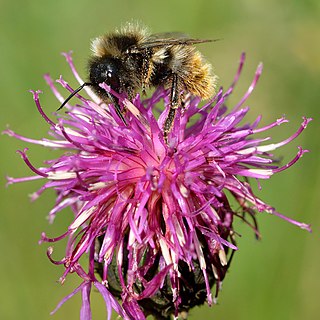
Bombus rupestris is a species of cuckoo bumblebee present in most of Europe except Iceland. In the Balkans it is found in montane and alpine habitats northwards from Central Greece. It is also found in Turkey.

Bombus balteatus, the golden-belted bumble bee, is a species of bumblebee with a boreal and high altitude distribution in northern Eurasia and North America.

Bombus consobrinus is a species of bumblebee found in Hungary, northern Scandinavia, Kazakhstan, Russia, China, North and South Korea, and Japan.

Bombus hortorum, the garden bumblebee or small garden bumblebee, is a species of bumblebee found in most of Europe north to 70°N, as well as parts of Asia and New Zealand. It is distinguished from most other bumblebees by its long tongue used for feeding on pollen in deep-flowered plants. Accordingly, this bumblebee mainly visits flowers with deep corollae, such as deadnettles, ground ivy, vetches, clovers, comfrey, foxglove, and thistles. They have a good visual memory, which aids them in navigating the territory close to their habitat and seeking out food sources.

The brown-banded carder bee is a bumblebee found in most of Europe west of Russia, with the exception of Ireland and Iceland. It is also found in Turkey, on the Tibetan plateau, northern China, eastern and southern Mongolia, and parts of North Korea. In Britain, it is limited to the coast and chalkland areas of southern England. The brown-banded carder bee is similar in appearance to the moss carder bee. As they share similar habitats, care must be taken to distinguish between the two.

Bombus pensylvanicus, the American bumblebee, is a threatened species of bumblebee native to North America. It occurs in eastern Canada, throughout much of the Eastern United States, and much of Mexico.

Bombus fervidus, the golden northern bumble bee or yellow bumblebee, is a species of bumblebee native to North America. It has a yellow-colored abdomen and thorax. Its range includes the North American continent, excluding much of the southern United States, Alaska, and the northern parts of Canada. It is common in cities and farmland, with populations concentrated in the Northeastern part of the United States. It is similar in color and range to the American bumblebee. It has complex behavioral traits, which includes a coordinated nest defense to ward off predators. B. fervidus is an important pollinator, so recent population decline is a particular concern.
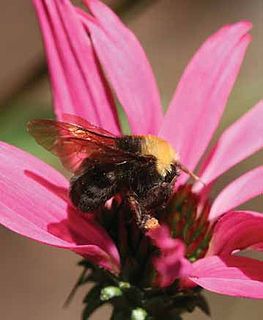
Franklin's bumblebee is known to be one of the most narrowly distributed bumblebee species, making it a critically endangered bee of the western United States. It is known only from a 190-by-70-mile area in southern Oregon and northern California, between the Coast and Sierra-Cascade mountain ranges. It was last seen in 2006. Franklin's bumblebee is known to collect nectar and pollen from several wildflowers, such as lupine, California poppy, and horsemint, which causes it to be classified as a generalist forager.
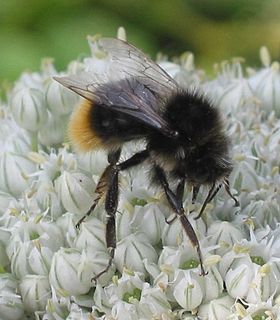
Bombus ruderarius, commonly known as the red-shanked carder bee or red-shanked bumblebee, is a species of bumblebee found in Eurasia.

Bombus eximius is a species of bumblebee that belongs to the subgenus Melanobombus in the simplified subgeneric classification. It is found in the Southern, Eastern and Southeastern parts of the Asian continent.
Bombus mongolensis is a species of bumblebee that primarily lives in Mongolia. It lives at altitudes ranging from 1,300-2,100 meters.
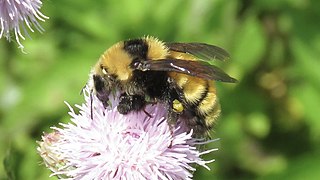
Bombus borealis is a species of bumblebee known commonly as the northern amber bumblebee. It is native to northern North America, where it occurs across Canada and Alaska and the northern and eastern contiguous United States.
Bombus amurensis is a bumblebee belonging to the subgenus Subterraneobombus, first described by Radoszkowski in 1862. It lives primarily in China, Mongolia and the far south-east of Russia.
















